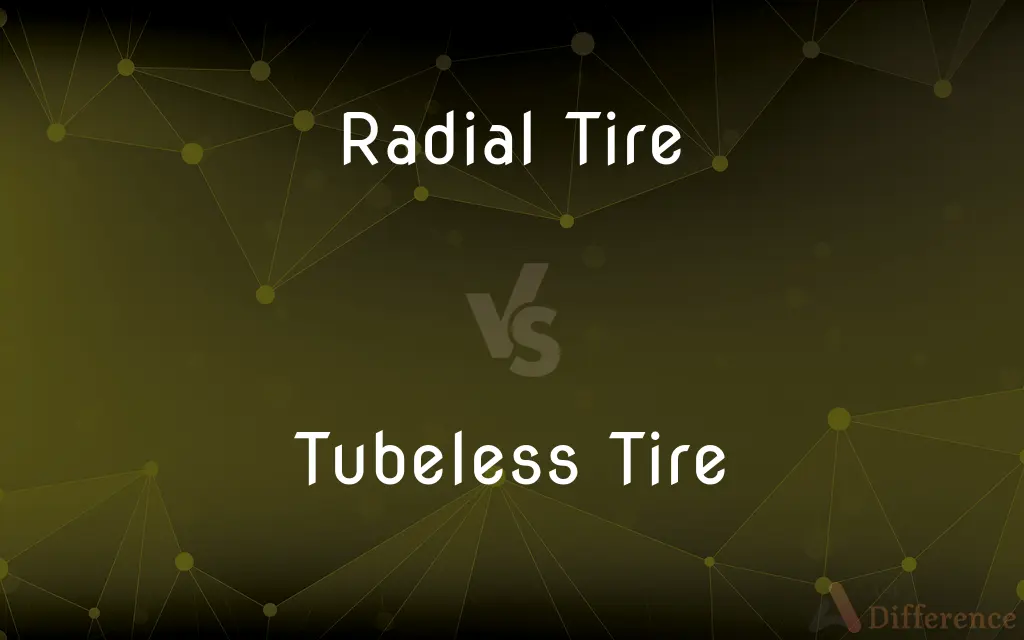Radial Tire vs. Tubeless Tire — What's the Difference?
By Maham Liaqat & Urooj Arif — Published on December 1, 2024
Radial tires, known for their layered construction that enhances durability and fuel efficiency, differ from tubeless tires, which eliminate the need for an inner tube, reducing flats and improving performance.

Difference Between Radial Tire and Tubeless Tire
Table of Contents
ADVERTISEMENT
Key Differences
Radial tires are defined by their construction, featuring perpendicular steel belts to the tread and a series of fabric layers, offering improved road contact, stability, and tread life. This design reduces heat build-up and offers better fuel efficiency compared to traditional bias-ply tires. Tubeless tires, on the other hand, are not a construction style but a type that lacks an inner tube, sealing air directly within the tire itself. This design reduces the risk of sudden flats due to punctures and offers a self-sealing capability for small punctures, enhancing safety and performance.
The primary benefit of radial tires lies in their tread life and fuel efficiency. The construction allows for less rolling resistance, which not only saves on fuel costs but also contributes to a smoother ride with better handling. Tubeless tires contribute to safety and convenience, offering a lower chance of sudden air loss and easier maintenance. They can also run at lower pressures, which is advantageous for off-road conditions, providing better traction.
Safety features between the two types also differ. Radial tires' structure offers better control and stability, especially at high speeds, due to their flexible sidewalls and efficient heat dissipation. Tubeless tires enhance safety by reducing the risk of blowouts. The absence of an inner tube means that air escapes more slowly in case of a puncture, allowing for controlled and safer handling until the tire can be repaired.
Compatibility and usage scenarios for each tire type vary. Radial tires are widely used across various vehicle types, from cars and trucks to motorcycles, for their general performance advantages. Tubeless tires have become increasingly popular in bicycles, motorcycles, and cars for their puncture-resistant qualities and ease of repair. Some radial tires are also tubeless, combining the benefits of both designs for maximum efficiency and safety.
The choice between radial and tubeless tires depends on specific needs, radial tires for durability and efficiency, and tubeless tires for safety and reduced maintenance concerns. Advances in tire technology often blend the advantages of both, offering drivers and cyclists a range of options to suit various driving conditions and preferences.
ADVERTISEMENT
Comparison Chart
Construction
Steel belts run perpendicular to the tread
No inner tube, air is sealed within the tire
Benefits
Improved fuel efficiency, durability, handling
Reduced flats, better performance, can self-seal small punctures
Safety Features
Better control and stability at high speeds
Lower risk of blowouts, safer in case of puncture
Compatibility
Cars, trucks, motorcycles
Cars, motorcycles, bicycles; some radial tires are also tubeless
Main Usage
General driving, offering long tread life
Off-road, sports, and everyday driving for enhanced safety and convenience
Compare with Definitions
Radial Tire
Reduces heat build-up during driving.
Radial tires are preferred in hot climates for their durability.
Tubeless Tire
Reduces the risk of sudden flats.
Off-road vehicles often use tubeless tires to navigate rough terrain safely.
Radial Tire
Suitable for a variety of vehicles.
From motorcycles to heavy-duty trucks, radial tires are a versatile option.
Tubeless Tire
Can self-seal minor punctures.
Tubeless tires on bicycles allow riders to continue even after a puncture.
Radial Tire
Features perpendicular steel belts for durability.
Modern cars typically come equipped with radial tires for their efficiency.
Tubeless Tire
Offers easier maintenance.
Patching a tubeless tire can often be done without removing it from the rim.
Radial Tire
Designed for improved fuel efficiency.
Long-haul trucks use radial tires to reduce fuel consumption.
Tubeless Tire
Provides better traction at lower pressures.
Mountain bikes with tubeless tires excel on uneven surfaces.
Radial Tire
Offers better handling and stability.
Sports cars benefit from the enhanced control provided by radial tires.
Tubeless Tire
Eliminates the need for an inner tube.
Many modern motorcycles feature tubeless tires for improved safety.
Common Curiosities
Can a tire be both radial and tubeless?
Yes, many modern tires combine radial construction with tubeless technology for combined benefits.
What makes radial tires more fuel-efficient?
Their construction reduces rolling resistance, requiring less energy for movement.
What is the main advantage of tubeless tires off-road?
They can run at lower pressures for better traction and are less likely to suffer flats from punctures.
What safety features do tubeless tires offer?
They provide a safer driving experience by reducing the chance of blowouts and allowing for controlled handling in case of a puncture.
How do tubeless tires reduce the risk of flats?
They seal air directly within the tire and can self-seal small punctures, preventing sudden air loss.
How do radial tires affect tread life?
Their design evenly distributes contact with the road, reducing wear and extending tread life.
Why are radial tires preferred in hot climates?
Their construction helps dissipate heat more efficiently, reducing the risk of tire failure due to overheating.
Do tubeless tires require special rims?
Yes, they require rims that can seal the bead of the tire to hold air without an inner tube.
Why do radial tires offer better handling?
The flexible sidewalls and efficient tread design provide improved road contact and stability.
Are tubeless tires suitable for all vehicles?
While increasingly common, compatibility depends on the vehicle and rim design; not all vehicles are equipped to use them.
Can you repair a tubeless tire easily?
Yes, small punctures in tubeless tires can often be repaired without removing the tire from the rim.
Are radial tires better for the environment?
Their longer lifespan and fuel efficiency can contribute to reduced waste and energy consumption, offering some environmental benefits.
What is the cost difference between radial and tubeless tires?
The cost can vary based on brand and specific tire features, but tubeless tires may be slightly more expensive due to their additional benefits.
How long have radial tires been in use?
Radial tires have been widely used since the 1940s, gradually becoming the standard due to their advantages.
What happens if a tubeless tire gets a large puncture?
Larger punctures may require a tire plug or patch from the inside, similar to traditional tire repairs.
Share Your Discovery

Previous Comparison
Saving vs. Investment
Next Comparison
Glassfish vs. TomcatAuthor Spotlight
Written by
Maham LiaqatCo-written by
Urooj ArifUrooj is a skilled content writer at Ask Difference, known for her exceptional ability to simplify complex topics into engaging and informative content. With a passion for research and a flair for clear, concise writing, she consistently delivers articles that resonate with our diverse audience.













































